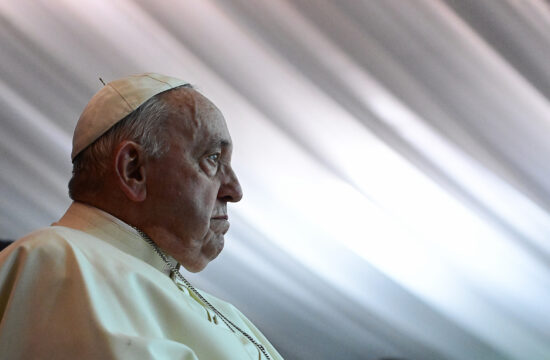The appearance of Russia’s new 5th generation single engine light fighter at the International Aviation and Space Salon surprised the aviation community worldwide. Partly breaking with the Russian aeronautical tradition of the past decades, this fighter aircraft with a single-engine design could finally bring the long-awaited breakthrough for the Russian aerospace industry. What is behind the new “Checkmate” and how can it change Russia’s aviation industry?

Photo:EUROPRESS/Dimitar DILKOFF/AFP
Not so long ago, Rostec’s announcement of a ground-breaking new Russian fighter aircraft was an unexpected surprise at the MAKS, one of Europe’s largest airshows. Although, as previously reported by our portal, both the Russian Aerospace Forces and the United Aircraft Corporation (UAC) have been interested in developing a new single-engine, 5th generation light fighter, its debut was predicted by the aviation community to be at best only in the second half of the 2020s. However, despite these forecasts and the negative experience gained from the protracted developments in recent decades, as the public was able to see on Tuesday
„Russia has developed in record time a fighter aircraft that meets the requirements of modern air combat”
As Sergei Chemezov, Rostec’s CEO, explained, in little over a year, the Sukhoi design bureau has succeeded in creating a fully operational prototype of a completely new aircraft, using computer modelling, virtual test flights to facilitate aerodynamic design work and integrating already available subsystems. Although the concept of a Light Multi-Function Frontal Aircraft (LMFS) had also been studied by Mikoyan-Guryevich – another UAC affiliate – the real breakthrough came with the merger of the two offices. By eliminating parallel structures and streamlining development, while the LMFS project eventually remained in the drawer, the engineering experience was kept alive at Sukhoi.
According to the information currently available for the general public and Rostec’s presentation on Tuesday, the Checkmate – officially referred to as the Sukhoi LTS, or Legkiy Takticheskiy Samolet (Light Tactical Aircraft) – is
“essentially a single-engine version of the long-in-development Su-57 Felon”.
According to figures presented by Rostec, the Checkmate has a maximum top speed of more than Mach 1.8 – around 2,200 km/h – with a range of 2,800 kilometres without external fuel tanks or aerial refuelling. In terms of payload, the Checkmate can carry a maximum of 7,400 kilograms of armament on its external and internal hardpoints. An interesting aerodynamic design feature is the characteristic shape of the chin-mounted air intake and the all-moving V-tail. What the latter essentially means is that the so-called butterfly tail replaces the traditional vertical and horizontal stabilizer with two surfaces in a V-shaped configuration. As we can see on the former Nothrop YF-23 the V-tail together with the advanced flight control system can replace traditional control surfaces, further reducing the radar cross-section of the stealth fighter.

Photo:EUROPRESS/Pavel Bednyakov/Sputnik/AFP
The aircraft has all the features of a 5th generation fighter: stealth technology, reduced radar cross-section (RCS), internal weapons bay, AESA (active electronically scanned array) radar and sensor fusion, the latter two setting new standards compared to previous avionics. All this is combined with a high thrust-to-weight ratio – greater than one, as previously set out in the requirements by Rostec – as well as weapons payload and internal fuel capacity. After all, in addition to flight characteristics and armament, the usefulness of a given fighter is mainly influenced by its range and combat range. Take the example of the American F-15 F-16 heavy and light fighter duo. The smaller, single-engine F-16 has a slightly shorter, but virtually identical combat range to the F-15 heavy fighter. In contrast, let us look at the case of the MiG-29, developed in the same period. Due to the notoriously low amount of internal fuel and the twin-engine design, the aircraft’s range was always too short, which proved insufficient even in the European theatre of operations with smaller distances. While the F-16 has become the most successful light fighter of recent decades, the MiG-29 is kept in service in minimal numbers even by the successor of its developer state.
“Beyond flight characteristics, relatively little is known about the Checkmate’s combat capabilities. According to Rostec’s presentation, the fighter can simultaneously track 30 and attack six air targets”
For targets on land and water, the number of targets that can be attacked simultaneously is reduced to two. For the armament, the internal weapon bay can accommodate five air-to-air missiles, but depending on the mission, these mounting points can also accommodate several types of guided munition or unguided rockets. By comparison, the rival F-35 has four internal and six external stations. The export orientation is clearly indicated by the fighter’s open architecture on-board electronics, which can integrate foreign-made systems and armament in addition to Russian ones, if required. Such a demand is most likely to arise from customers in South-East Asia or the Middle East. Just think about the French-made avionics or the Israeli-made air-to-air missiles of the Indian Su-30MKI fleet.

Photo:AviaNews/Telegram
According to information provided by Rostec, artificial intelligence will play a major role during the operation of Checkmate. This can not only reduce the pilot’s workload in combat situations and during flight – such as automatic identification and specification of targets – but also greatly simplify the maintenance process. From a Russian point of view, the Matryoshka computerized maintenance management system is particular novelty, which continuously monitors the fighter aircraft itself and its components based on on-board sensors and flight time. Based on the data collected, the system – similar to the one on the F-35 – will inform the ground crew in advance which type of maintenance is required, along with the possible replacement of parts.
“Due to the high level of automation provided by Matryoshka, maintenance costs can be significantly reduced, while improving combat readiness.”
According to chief designer Mikhail Strelets, another benefit of the extensive use of artificial intelligence on board is that it allows the pilot to skip the pre-take-off checklist. More precisely, it does not require human presence, as it is carried out by the AI itself much faster than a human, reducing the reaction time between, for example, an alert and take-off. The AI essentially acts as a virtual co-pilot and according to some industry sources, it can return the aircraft to base and even land on autonomously in the event of a pilot becoming unconscious or injured. Rostec also plans to develop an unmanned version, based on current artificial intelligence, which can even cooperate with its piloted companion as a kind of swarm to carry out joint operations.
While it was clear that for previous generations, the US and Russia/Soviet Union dominated the market for fighter aircrafts worldwide, the rapid economic development during the last decades has led to the sudden emergence of the Chinese aerospace industry with significantly lower priced models than the competition. These are replacing the former Soviet designs, mainly in the Southeast Asian region and across Africa, depriving Russia from sales opportunities. A similar problem arises from the lack of a single-engine light fighter on the Russian side, as Russia is losing a significant proportion of potential customers with a smaller budget. This is particularly true in the present situation, as the Russian repertoire is limited to twin-engine variants for both the 4th and 5th generations.
“Essentially, Russia itself would not necessarily need a single-engine fighter, considering its natural conditions, and the vast distances in the country favour the use of twin-engine fighters”
However, in addition to the export opportunities mentioned above, the lower procurement and operating costs and the high interoperability with the Su-57 make it financially feasible for VKS to take the fighter into service. Not all combat situations require a heavy fighter with a maximum take-off weight well in excess of 30 tons, especially if the extremely short range of the less successful MiG-29 can be avoided. On the other hand, the lower procurement costs will allow more fighters to be entered service.
According to Sergei Chemezov, the unit price of the new aircraft is expected to vary between $25 and $30 million. By comparison, the price of the other Russian fifth-generation Su-57 is estimated at $100 million per unit for export – which is naturally much higher than the domestic price as for all arms deliveries – while the projected value of the F-35 contracts for a given fighter ranges between $110 million and $150 million. It is important to note that these projected figures are largely indicative, as they include not only the fighters themselves but also the supporting infrastructure, armaments and other support, which vary from deal to deal.
A large part of the cost reduction is due to the fact that most of the systems used on the aircraft, the engine –Izdeliye 30 on the final product – or even the nose section, which includes the cockpit, are already available for the Su-57, so Rostec could save time and money in their development
In an interview with Mikhail Strelets, the chief designer said that the Checkmate’s cost per flight hour will be one-seventh of the F-35 and roughly on par with the Swedish Gripen. Of course, this figure will be affected by fluctuations in the ruble exchange rate and the fiscal year for which Sukhoi has calculated the cost per flight hour for the F-35. But even if the final product does not meet the pre-set price level and operating costs, it will still be the cheapest fifth-generation fighter. Both ahead of its Western and Eastern competitors. Minister of Industry and Trade Denis Manturov has named the US F-35, Swedish Gripen, French Rafale and Chinese JF-17 Thunder as main competitors to the proposed design. The latter could soon be accompanied by the Chinese 5th generation FC-31, which, like the Checkmate, is aimed at countries with smaller budgets, but in a twin-engine – and therefore more expensive – design due to a lack of suitable propulsion.

Photo:Wikipédia
“But beyond this, the pace of development will undoubtedly be largely determined by foreign interest. If the new lightweight fighter succeeds in attracting the attention of potential export customers, and if they are even willing to contribute financially to its development – which would not be unprecedented – the progress of its development could be significantly accelerated”
Otherwise, in the absence of sufficient interest, Moscow will focus on the already operational Su-57 and its production, dedicating far fewer resources to the new project. In addition, although the Air Force has shown great interest in the Checkmate program, it is likely that we will have to wait for a VKS order. Anyway, the latter is almost certain to happen, as traditionally the first operator of a military technology is its developer state, otherwise it will be almost impossible to sell the product abroad.
As Deputy Prime Minister Yuri Borisov explained, the potential international market for a new Russian fighter aircraft over the next 15 years is currently estimated at more than 300 units. A possible larger order could expand this further. South and South-East Asia – with India as the largest potential customer – the Middle East and Latin America are prominent among the potential export markets. Interestingly, Yuri Slyusar even mentioned the possible European operation of Checkmate during the presentation, but without naming a concrete destination. Considering the current geopolitical situation on the continent, Serbia is the most suitable candidate. The latter is confirmed by the fact that the Serbian Minister without portfolio, Nenad Popovic, personally inspected the cockpit after the demonstration.
According to some reports, a foreign customer has already expressed an interest in the aircraft, but it is not yet clear who exactly. On one hand, India has had an ultimately unsuccessful cooperation with Russia on the production of an Indian version of the Su-57 (FGFA), while on the other hand, Russia signed a Memorandum of Understanding with the United Arab Emirates for the development of a 5th generation light fighter in February 2017.
“According to the timetable presented to the press, Checkmate’s maiden flight could take place in 2023, which will be followed by the production of several prototypes. Serial production could begin in 2026-27, after the completion of various flying tests”
In order to ensure adequate export success, it will be crucial for Rostec to stick to the published timetable and minimise delays. A protracted development program similar to that of the Su-57 will allow competitors to acquire potential Russian orders. On one hand, the experience of recent years suggests that a certain amount of delay is inevitable given the level of complexity of the design. On the other hand, as the Checkmate has gone from scratch to the present level with a surprising speed – unseen since the 1960s-, there are many glimmers of hope for the future of the fighter. From what we have seen so far, Russia has taken a giant leap forward in the development of military fighters. But Rostec engineers still have a lot of work to do to make the Checkmate a reality on the battlefield.












